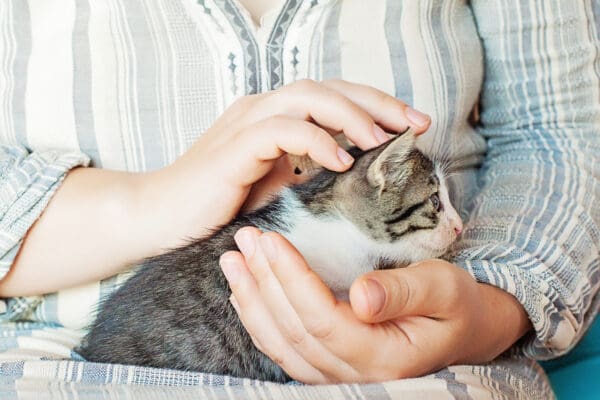
11401 NE 195th St. Bothell, WA 98011
(425) 486-9000 PHONE (425) 486-9002 fax
Parrots are wonderful companion pets. However, rescue facilities are full of pet parrots that have been abandoned by their owners, many times for undesired behaviors that are for the most part preventable.
All pet parrots should be willing to do the following:
- Step-up and step-down, onto and from: the owner’s hand, all members of the household and confident strangers
- Stay on a perch or play gym when put there
- Willingly enter the cage or carrier
Step-up: Step-up is the first basic command to teach your bird, and is the key to many hours of enjoyable interaction between you and your pet.
- Confidently ask your bird to “step up” while placing your hand immediately in front of the parrot’s feet. Hold a favorite treat in your other hand to help encourage your bird to come forward.
- When your bird leans forward to take the treat, offer verbal praise immediately and give him/her the treat. Repeat this process, asking a little more of your bird each time. For example, initially you will reward any forward movement towards your hand. Then, wait to reward your parrot until you see one of his/her feet moving towards your hand. Then, wait to reward your parrot until he/she touches your hand with a foot… etc. It may take only one training session or several training sessions before your parrot is comfortable with this process.
- Once your bird steps up willingly on your hand, ask your bird to “step down” onto perches, the cage, or other locations by holding your hand close to these surfaces and offering your bird a treat once he/she steps onto the new surface. Some birds may be fearful of new surfaces, so move slowly and use lots of praise and encouragement.
If your parrot is consistently treated with respect and gentleness during this process, he/she will most likely be begging to step up at this point! You will be seen as the source of all treats, and your parrot will enjoy socializing with you. This behavior pattern should be “transferred” to everyone your bird meets, so that anyone can pick up your pet. A parrot that is only handled by one person can become aggressive or fearful towards other people due to poor socialization.
In order to “transfer” this behavior pattern, have all members of the family who are able to handle the bird safely regularly reinforce the step up and step down command with lots of practice, praise, and treats. You should also arrange for your bird to meet “parrot savvy” strangers inside or outside the home who can further reinforce the positive experiences associated with stepping up. This type of relaxed socialization is very important to help develop happy, confident feathered friends!
Stay: Polite birds should stay on a perch or playstand when told to, and not jump off to follow the owners/explore the house. Not only is it annoying to be constantly chasing your bird down, your bird could be exposed to many dangers by being in a non-parrot proofed area of the house unsupervised.
- Place the bird on the perch and tell him/her to “stay.”
- When your parrot stays on the perch for a VERY short period of time, instantly reward him/her with a favorite treat. Gradually increase the amount of time between telling your bird to “stay” and providing a reward. Be sure your parrot is rewarded with food, toys, and regular attention for staying put.
- If your parrot jumps off the playstand, immediately say “No” and replace him/her back on the playstand. Continue rewarding your parrot for good behavior as described above. If your parrot repeatedly jumps off the playstand, give him a “time-out” within his regular cage for 3-5 minutes. Do not give him any food, attention, or toys during this time-out. After the end of the time-out, training can resume.
It is very important to stay calm and consistent during these training sessions. Your parrot is very smart, and will learn quickly once he/she knows the rules are non-negotiable.
Go Home: Birds should be willing to go back into the cage or carrier when asked. If you are ever involved in an emergency (house fire, earthquake, etc.), your bird’s willingness to respond quickly to these commands could mean life or death!
- This command can be taught very similarly to the “step-up” command. Start by introducing your bird to the carrier. Act very excited and tell your bird how happy you are that he/she has such a nice carrier. Give your bird several treats for investigating the carrier. Do not place the bird inside the carrier or ask him/her to enter the carrier.
- After your bird is very comfortable around the carrier, place some treats right in the opening to the carrier. Praise your bird whenever he/she is brave enough to get the treats out of the carrier opening. Gradually move the treats deeper into the carrier until your bird has to step into the carrier to retrieve them. When your parrot enters the carrier, tell him/her “Go Home” and then praise them for doing so!
- While your bird is inside the carrier eating treats, quietly close the carrier door, then immediately open it again. Gradually leave the door closed for longer periods of time. Make sure that your bird always has fun treats/toys to entertain him/her during these practice times.
Again, with patience and persistence, your bird will quickly learn to associate the carrier with good things, and will be very eager to go inside when asked.
There are many other behaviors that you can train your bird to do using similar techniques described here. We strongly recommend using target training and clicker training techniques, as these can greatly expand your birds’ horizons and create hours of enjoyable interaction between the two of you (see Target Training handout by Susan Friedman and/or Barbara Heidenreich’s bird training materials for help with this).
March 30, 2015
Content of this Care Sheet Courtesy of:
The Center for Bird and Exotic Animal Medicine
11401 NE 195th St. Bothell, WA 98011
(425) 486-9000 PHONE (425) 486-9002 fax



